Clogheen, Co. Tipperary
Clogheen Poor Law Union was formally declared on the 2nd February 1839 and covered an area of 114 square miles. Its operation was overseen by an elected Board of Guardians, 18 in number, representing its 12 electoral divisions as listed below (figures in brackets indicate numbers of Guardians if more than one):
Co. Tipperary:
Ardfinnan, Ballybacon, Ballyporeen (2), Caher (3), Clogheen (2), Deragrath, Newcastle, Tubrid (2), Tullahorton, Tullamealon, Whitechurch.
Co. Limerick:
Kilbenny (2).
The Board also included 6 ex-officio Guardians, making a total of 24. The Guardians met each week on Monday.
The population falling within the Union at the 1831 census had been 40,935 with divisions ranging in size from Whitechurch (population 1,064) to Caher (9,229).
The new Clogheen Union workhouse was erected in 1840-42 on a six-acre site half a mile to the south-east of Clogheen. Designed by the Poor Law Commissioners' architect George Wilkinson, the building was based on one of his standard plans to accommodate 500 inmates. Its construction cost £5,230 plus £935 for fittings etc. The workhouse was declared fit for the reception of paupers on 24th March 1842, and received its first admissions on 29th June. Its location and layout are shown on the 1907 map below.
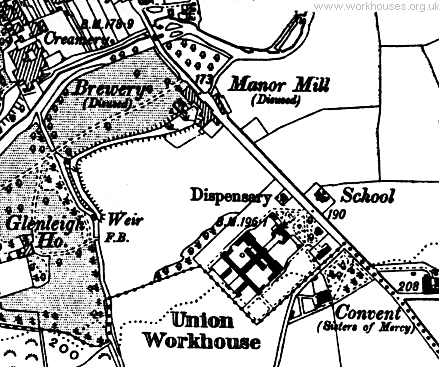
Clogheen workhouse site, 1907
The buildings followed Wilkinson's typical layout. An entrance and administrative block at the east contained a porter's room and waiting room at the centre with the Guardians' board room on the first floor above. (The central part of this block has been demolished.)
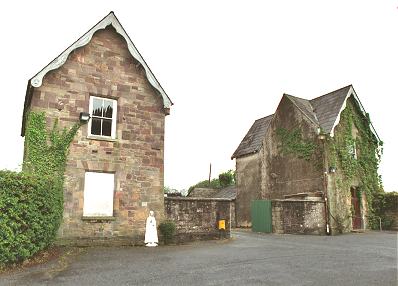
Clogheen entrance and administrative block from the east, 2002
© Peter Higginbotham.
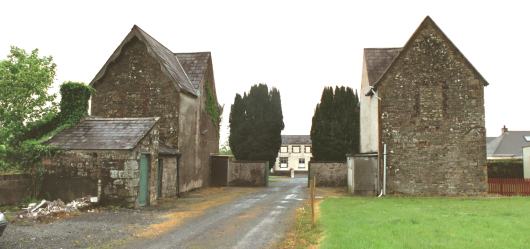
Clogheen entrance and administrative block from the west, 2002
© Peter Higginbotham.
The main accommodation block had the Master's quarters at the centre, with male and female wings to each side. At the rear, a range of single-storey utility rooms such as bakehouse and washhouse connected through to the infirmary and idiots' wards via a central spine containing the chapel and dining-hall.
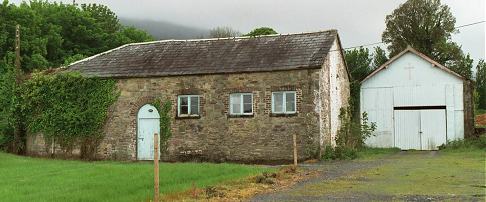
Clogheen remains of utility block and central spine from the east, 2002
© Peter Higginbotham.
During the famine in the mid-1840s, store sheds were initially adapted to accommodate 80 fever patients. The infirmary was later extended to accommodate an extra 45 fever patients.
In 1905, a dispensary was erected near to the road at the north of the site.
In 1922, the workhouse building was used to house boys transferreed from Clonmel Borstal Institution. Early on the morning of November 8, armed Republicans entered the premises. The inmates were placed in one part of the building while other parts were set on fire. The parts that were saved included the workhouse hospital and chapel. A view of the derelict entrance block in 1932 is shown below.
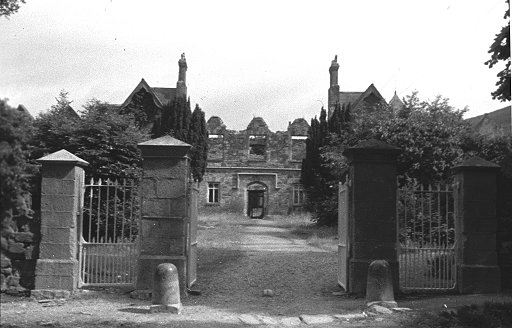
Clogheen workhouse entrance, 1932
(c) Weber/Cronin Collection
Records
Note: many repositories impose a closure period of up to 100 years for records identifying individuals. Before travelling a long distance, always check that the records you want to consult will be available.
- Tipperary Studies, The Source, Cathedral Street, Thurles, Co. Tipperary. Holdings include Board of Guardians' minutes (1839-1923).
Bibliography
- Famine In The Valley by Edmund O'Riordan (Galty Vee Valley Tourism, 1995)
- The Workhouses of Ireland by John O'Connor (Anvil Books, 1995)
Links
- None.
Unless otherwise indicated, this page () is copyright Peter Higginbotham. Contents may not be reproduced without permission.


